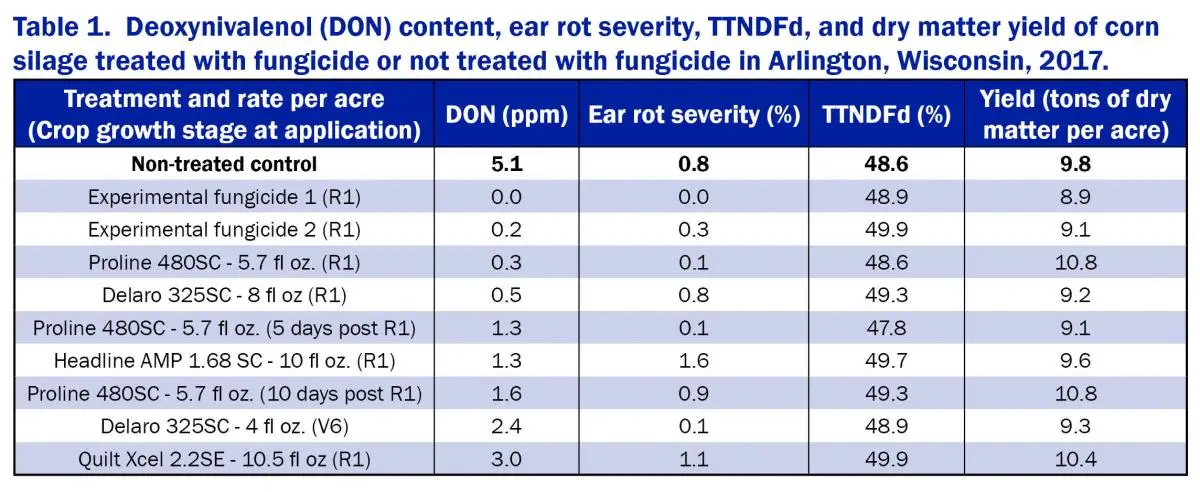
Ask the expert: Should I use fungicide to control vomitoxin in silage corn? – Dr. Damon Smith, University of Wisconsin-Madison
 By Dr. Damon Smith, University of Wisconsin-Madison assistant professor and extension specialist
By Dr. Damon Smith, University of Wisconsin-Madison assistant professor and extension specialistTreating field corn or grain with fungicide has become a common practice in the Midwest. With so many fungicide programs and formulations, and the re-emergence of yield-limiting corn diseases like Northern Leaf Blight and Gray Leaf Spot, fungicide application has demonstrated an ability to reduce foliar disease severity and increase grain yield.
More recently, research has been done on the application of fungicide to corn for silage. Dr. Felipe Cardoso, University of Illinois, has studied the effects of several fungicides on improving feed quality. While yield was not often directly impacted, fibrous changes in the corn plant improved feed conversion.
Another possible benefit to treating both silage corn and grain corn with fungicide is the potential to reduce mycotoxins, which are produced by fungi (primarily mold). Recent studies by colleagues in Ontario, Canada have demonstrated that the triazole-containing fungicide Proline® applied at R1 (silking) stage, or shortly after the beginning of silking, can reduce DON levels in corn grain, compared to not treating. The Field Crops Pathology Laboratory at the University of Wisconsin-Madison set out to determine the effects of common fungicides on silage corn.
Our trial was established at the UW Arlington Agricultural Research Station, located in Arlington, Wisconsin, in 2017. BMR corn was planted on May 11 and chopped on September 13. Single applications of various fungicide products were applied at growth stages V6 (19 June), R1 (26 July), 5 days post R1 (31 July), and 10 days post R1 (4 August). Ear rot severity was visually assessed on the day of harvest, DON was measured on chopped sub-samples from each plot, and yield was measured.
Results and treatments can be viewed in table 1 below.
Consistent with other datasets, we found no significant difference in yield or quality across treatments. This could be due to the fact we started with a high-quality BMR hybrid.
All fungicide treatments resulted in a significant reduction in DON, compared to the non-treated control, except Delaro™ applied at V6 and Quilt Xcel® applied at R1, which were numerically lower but statistically similar. Application of the Experimental Fungicide 1 resulted in the lowest DON content among treatments. Remaining treatments had comparable DON levels to Experimental Fungicide 1, except for Quilt Xcel at R1. These results, consistent with previous data from Canada, indicate a “sweet spot” of application timing to reduce DON. The window of application begins at R1 (silking) and ends around 10 days after the start of R1.
Additionally, our data showed the product Quilt Xcel does not reduce DON levels. In fact, in other trials, applying Quilt Xcel resulted in higher levels of DON in grain corn. In grass crops, like wheat, products containing the strobilurin fungicide class can increase DON levels. Therefore, these products are not recommended for application after flowering in wheat. This same phenomenon could be possible in corn. Thus, care should be taken when choosing products and programs specifically aimed at reducing DON levels in corn silage.
In summary, dairy farmers should think about the overall goal of using fungicide on silage corn. If the goal is to simply improve feed quality, you have plenty of products and application options to choose from. However, if the goal is to target mycotoxins, specifically DON, certain fungicide products may need to be applied specifically during the short silking stage of the corn plant to reduce DON levels.
| Category: |
Forage Foundations Forage harvesting Mycotoxins |


